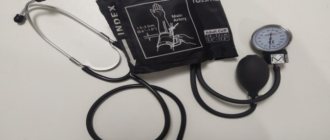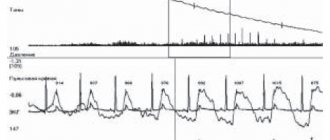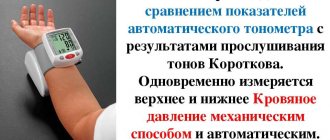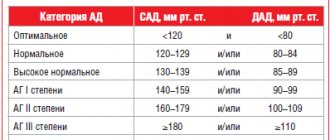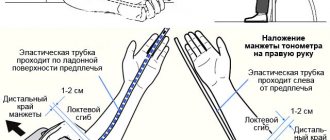Common mistakes when measuring blood pressure
Errors or incorrect actions, as well as factors influencing the result, when monitoring blood pressure may occur:
- in preparation for measuring blood pressure;
- when selecting and applying a tonometer cuff;
- during blood pressure measurement.
Mistake No. 1: lack of rest before measurement and emotional stress
If a person experienced emotional or physical stress immediately before the procedure, the pressure may increase by 10-15 mm. Hg Art. This also includes the so-called. “white coat syndrome”, when, due to anxiety at a doctor’s appointment, the patient experiences high blood pressure. A minimum of five minutes of rest is required before measuring blood pressure.
Mistake #2: Incorrect body position
When measuring blood pressure, a person should not stand or lie down or squat. The correct position during the procedure is sitting on a chair or chair, leaning your back on the back.
Mistake No. 3: misalignment of the hand relative to the level of the heart
The arm on which blood pressure is measured should lie freely on the table with emphasis on the elbow and be approximately at the level of the heart. If the arm and, accordingly, the tonometer cuff are located above the level of the heart, the pressure readings will be underestimated; if lower, they will be overestimated. Every 2-3 cm of movement of the hand up or down results in a distortion of approximately 2 mm. Hg Art.
Mistake #4: Incorrect foot position
When monitoring blood pressure, your legs should be level on the floor, not crossed or tucked in - this position slows down the flow of blood to the lower extremities and its flow back through the veins. Lack of support or unnatural position of the legs can increase the measurement result by 6-10 mm. Hg Art.
Mistake #5: Having a full bladder
You should urinate before measuring your blood pressure. A full bladder or the urge to urinate can lead to an increase in readings of 15-20 mm. Hg Art.
Error No. 6: tea, coffee, smoking before measuring blood pressure
Caffeine contained in tea and coffee, tonic drinks, and nicotine can increase blood pressure. After consuming the listed drinks and smoking, 1-2 hours should pass before blood pressure is controlled.
Mistake #7: Using eye and nasal drops immediately before the procedure
Many drops used for runny nose and ophthalmic diseases can slightly increase blood pressure. After using such drugs, you should wait 1.5-2 hours before measuring blood pressure.
Mistake No. 8: incorrect selection of the cuff and method of securing it
A standard cuff, usually included with a tonometer, is 22-32 cm long, suitable for people without excess weight and pronounced muscles. A cuff with a length of 15-22 cm is intended for measuring blood pressure in children and adolescents, 32-42 cm - in athletes and obese patients. The width of the cuff should be approximately 40% of the shoulder circumference, which is about 12-14 cm.
If the cuff is smaller than the required size, the result may be falsely high; using a large cuff may give underestimated results, and the error in one direction or another can range from 10 to 50 mm. Hg Art.
The cuff should not be fastened too tightly or loosely on the arm, or secured over clothing, with the exception of underwear, shirts made of thin material when using a semi- or automatic tonometer.
Mistake #9: Moving and talking while measuring
Talking and movement can increase blood pressure by up to 10 mm. Hg Art. Pressure should be measured in silence, the body should be in a calm, relaxed state.
Feature of the tonometer
Tonometers for home use are mechanical, mercury or electronic. “There are many cases when the tonometer shows the pressure incorrectly. Firstly, it could be an incorrectly applied cuff or insufficient air inflation. If it is a membrane-dial tonometer, then the needle may be faulty; if it is a mercury one, then the mercury reservoir is not filled properly. Electronic tonometers generally show pressure with an error of plus or minus 15 points of mercury,” says Karabinenko.
Article on the topic
Arithmetic for hypertensive patients. How to correctly calculate the appropriate pressure
Cuff selection
The accuracy of blood pressure measurements depends on the correct position of the cuff and its appropriate size for the arm. Before choosing a device, you need to find out how to determine the size of the tonometer cuff. To do this, you need to measure the circumference of your arm in the middle between the elbow and shoulder. If the number is less than 22 cm, you need a small cuff, and if it is more than 32 cm, you need a large one.
Beurer tonometers are equipped with three types of cuffs:
- Small – for shoulder coverage 22-30 cm;
- Medium or universal – 22-42 cm;
- Large – 30-42cm.
It is worth purchasing a device with a universal cuff to measure blood pressure for several family members with different shoulder coverage. If the size of the cuff does not fit the dimensions of your arm or the device is faulty, you can buy a new cuff for a specific tonometer model.
Impaired cuff filling
Impaired air filling of the cuff can be expressed in different ways. For example, if the blood pressure monitor does not inflate the cuff or deflates quickly, the cause may be:
- Damage to the cuff - there is a special chamber inside it that can wear out or become damaged. In this case, it begins to deflate;
- Contamination or failure of the valve responsible for retaining air in the cuff;
- Broken tubes or connector at the cuff connection point.
When the tonometer does not pump air, most often the problem lies in the integrity of the parts. Finding the specific cause of a malfunction and eliminating it yourself is extremely difficult; it is better to entrust the solution to this issue to professionals.
The opposite situation is that the tonometer does not bleed air when measuring pressure. The first thing to do in such a situation is to check the connection of the air tube to the cuff on one side and to the device itself on the other. To avoid this situation, it is enough to check that the tube is in its place.
But it also happens that the tube is damaged for some reason. You should not try to replace it with a similar part; only original components that are intended for a specific model are installed in tonometers.
How to take measurements correctly?
To ensure correct blood pressure measurements, you must not violate the following recommendations:
- Before the examination, if possible, you should rest and sit calmly for five minutes. If emergency assistance is required, this item can be neglected.
- Indicators may be overestimated if a person drank coffee or smoked during the last two hours before the study. You should give up bad habits for a short time, as the readings may be incorrect.
- To measure blood pressure, a person must be seated in a chair with a backrest. The back should be relaxed, legs lowered, not crossed or tense. Any violation can lead to serious errors, especially in the case of an electronic tonometer.
- The shoulder must be freed from clothing. It is necessary that she does not squeeze him.
- The hand must be placed on a table or stand so that it is closed at the elbow and at the same time completely relaxed.
- You need to check the electronic tonometer to ensure that there is no damage, kinks or kinks in the hose.
- The cuff should be unfastened and placed on the shoulder 2 centimeters above the elbow.
- You need to turn on the device using the button and wait for the automatic pumping and pumping of air. At this time nothing can be done.
- Wait until the numbers appear on the display and evaluate the results, then turn off the device and remove the cuff.
Measurement frequency for cardiovascular diseases
For vascular and cardiac disorders, blood pressure must be measured systematically. This is necessary to avoid the development of serious complications. Thanks to daily observation and recording of readings, the doctor will always be able to assess the effectiveness of the prescribed treatment, the accuracy of the chosen dosages and the risk of complications.
Hypertensive patients are often interested in how often they can measure their blood pressure with an electronic tonometer. With such a diagnosis, doctors recommend taking measurements on average three times a day:
- in the morning - at least an hour should pass after waking up;
- during the day – an hour after eating;
- in the evening - an hour after dinner.
The most common way to measure pressure is with an electronic tonometer, as soon as such nuances appear:
- severe changes in blood pressure are observed;
- taking new medications;
- dosage adjustment;
- a clear manifestation of VSD.
The number of measurements should also be adjusted depending on the severity of hypertension. If a person shows signs of a hypertensive crisis, then measurements are taken every 20-30 minutes.
Practical advice
For the picture to be true, you need to adhere to the following recommendations:
- when systematically measuring blood pressure, the indicators of each examination should be recorded, indicating the date, time and value of the indicators;
- periodically carry out control measurements using a mechanical tonometer;
- if the readings of the electronic and mechanical tonometers differ, then the data of the latter are considered true;
- During one session, it is better to measure the pressure several times on both hands.
The tips listed above will help you subsequently correctly assess the condition and choose the most effective treatment.
Mechanical damage and display problems
Mechanical faults occur as a result of damage to the device, for example, falling. If any element of the device is damaged, the only solution is to replace it with a new one. The cause of problems with displaying indicators on the screen is most often the detachment of the LCD display cable. In this case, individual segments of alphabetic or numeric symbols are not displayed. With such a malfunction you will have to contact a service center. The same applies to non-working buttons: repair involves disconnecting the electronic board and soldering in a new button.
When is constant blood pressure monitoring important?
How many times you can measure your blood pressure with an electronic tonometer can be discussed with your doctor. If pathological processes have been identified in a person, then measurements are recommended to be carried out at a constant frequency. This applies to people with the following diseases and conditions:
- hypotensive and hypertensive;
- smokers;
- diabetics;
- people over 50 years old;
- during pregnancy;
- with alcohol abuse;
- people who, due to their occupation, bear excessive responsibility;
- those who painfully perceive all kinds of tense and exciting situations;
- people with defined sleep disorders and lack of adequate rest.
If the conditions listed above are present, the doctor must inform the person how often he should measure the pressure with an electronic tonometer in order to correctly interpret the picture of the condition.
Replacing batteries and caring for the tonometer
Often problems with measuring pressure arise due to discharged batteries. Before using the device, you should check the batteries and replace them if necessary. Many blood pressure monitors indicate on the screen that the batteries are low using a special icon. The same applies to models with a battery that needs to be recharged in a timely manner.
If the indicator indicates low batteries, you must reset the result, turn off the device and replace the batteries. Only then should the measurements be repeated.
Another cause of malfunctions is improper care of the device and violation of the rules for storing it. The tonometer needs to be cleaned from time to time using a slightly moistened cloth. Do not treat the device with cleaning agents or solvents.
Neither the device nor the cuff should be immersed in water, as this will cause damage. You should also not place heavy objects on them, and strong bends in the hoses are not allowed. Before long-term storage, remove the batteries. Do not store the device near a heat source, for example, near a battery.
Interval between procedures
The question of how often you can measure blood pressure with an electronic tonometer is very relevant. Medical professionals unanimously believe that the frequency of monitoring depends on certain factors. People in excellent shape can take measurements from time to time, but those who suffer from cardiac diseases should approach the procedure responsibly and monitor their blood pressure more often. In old age, frequent measurements are contraindicated. This is due to the extreme fragility of blood vessels. To determine how often you can measure your blood pressure with an electronic tonometer, you need to evaluate the following factors:
- general well-being of a person;
- age;
- presence of concomitant diseases;
- features of previously suffered diseases;
- a type of tonometer.
All people, without exception, should monitor their blood pressure, only the frequency of measurements in each case may differ significantly. For example, it is enough for a healthy person to take measurements once every few months. And for those who suffer from cardiac ailments, blood pressure should be measured daily.
